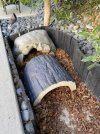MethodAgent
New Member
Hi everyone,
We have a russian tortoise that is outside 24/7. She has the run of the backyard. Normally she disappears in Late September/Early October and we see her again in February. In 2019 we redid our backyard and there is a lot more rock than dirt. I made a run for her and she has a spot where she can come and go from the run as she pleases. She often travels around the perimeter of our yard which has trees and bushes and then comes back here or in another spot at night to rest.
My concern is normally she disappears to brumate, I literally have no idea where she goes off to. However, this time she is in her little cave. My concern is if this is to pen for her to brumate successfully. I moved her log closer to the cave opening to provide a little more cover and piled up some wood chips for her to burrow into. I am not used to seeing her out like this during this time. She has not been out of the cave in a couple weeks, but I occasionally see she has moved around or hear scraping.
I guess my question is if I should leave her be, or pull her out and brumate her in a plastic bin in our garage (I did this one year during construction). My gut tells me to leave her be and she will come out if she needs something.....



We have a russian tortoise that is outside 24/7. She has the run of the backyard. Normally she disappears in Late September/Early October and we see her again in February. In 2019 we redid our backyard and there is a lot more rock than dirt. I made a run for her and she has a spot where she can come and go from the run as she pleases. She often travels around the perimeter of our yard which has trees and bushes and then comes back here or in another spot at night to rest.
My concern is normally she disappears to brumate, I literally have no idea where she goes off to. However, this time she is in her little cave. My concern is if this is to pen for her to brumate successfully. I moved her log closer to the cave opening to provide a little more cover and piled up some wood chips for her to burrow into. I am not used to seeing her out like this during this time. She has not been out of the cave in a couple weeks, but I occasionally see she has moved around or hear scraping.
I guess my question is if I should leave her be, or pull her out and brumate her in a plastic bin in our garage (I did this one year during construction). My gut tells me to leave her be and she will come out if she needs something.....


